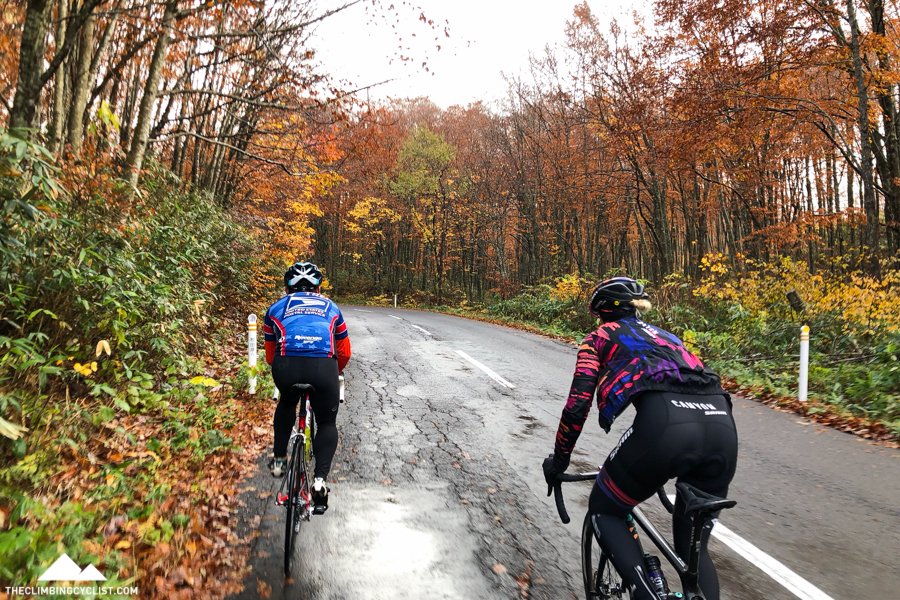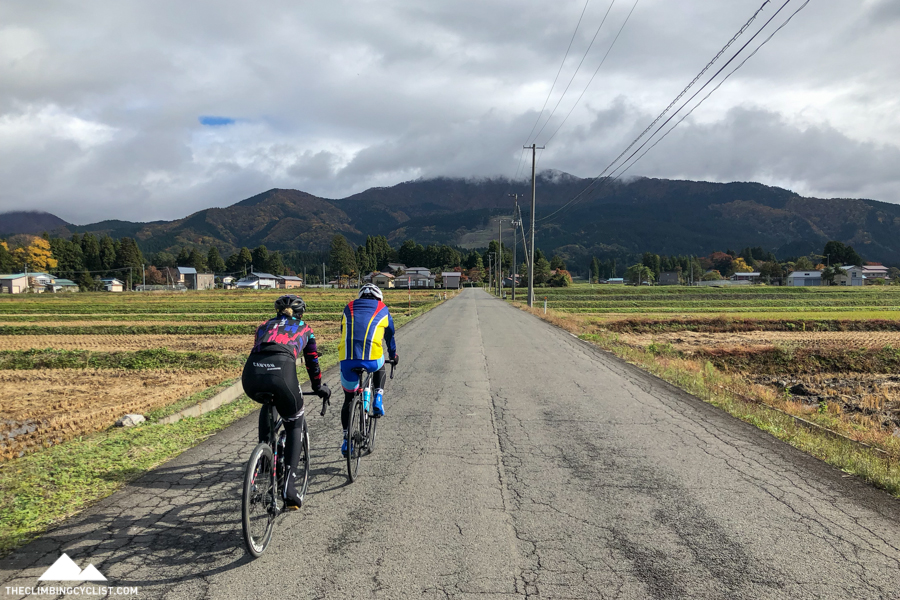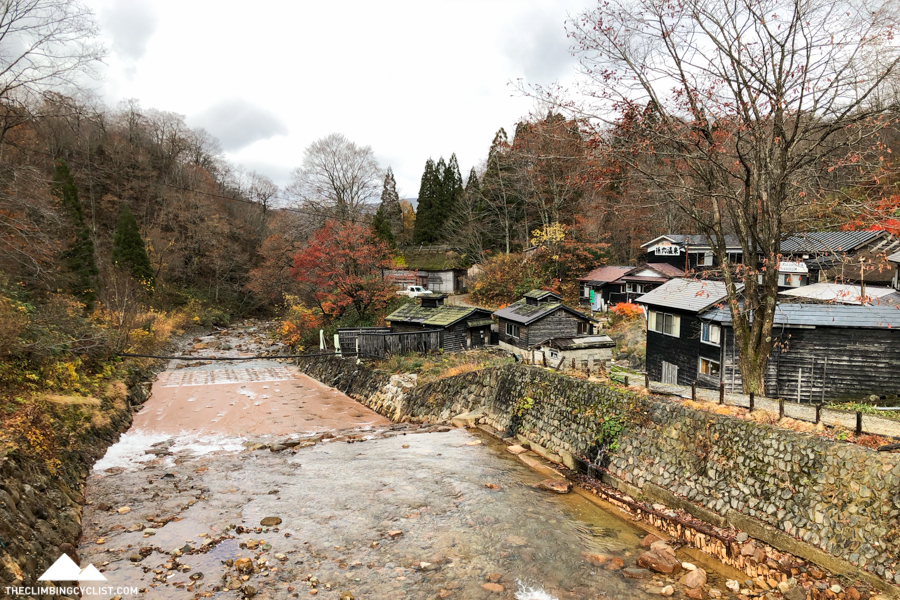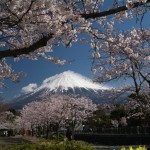Chapter V: Old Mate
The signs by the roadside read 3ºC as we near the base of the climb. To the right of the bus, and far above us, Onamedake Peak is covered in snow, the bright white mountaintop offering a striking contrast to the overcast sky.
It’s the start of our second day’s riding and our itinerary has us starting with a “hill climb”. With limited information to go off, it’s not clear whether that snowy peak is our destination. I’m both excited and terrified at the prospect.

I’ve always loved riding in the snow and few things are more beautiful than reaching the top of a snow-covered mountain by bicycle. But I’m also hideously underdressed and I know all too well what descending a snowy mountain without appropriate clothing is like.
With Onamedake Peak as our backdrop we pose for a few departure photos and videos and then we’re off. Us Aussies — me, Tiff, Ryan and Damian — are joined by a couple of local guides, one of whom earns himself the nickname “Old Mate” within mere minutes of setting off.

There’s no warm-up. We’re straight into the climb — nearly 10km of it — and Old Mate is straight to the front, tapping out an infernal tempo. Tiff speaks for all of us when she yells “sumimasen, tranquilo?!”, her plea a melding of languages that needs little translation. We’ve set out too hard, particularly given the 10% gradient we’ve found ourselves on.
Old Mate appears to be unperturbed. One by one we drop his wheel, each of us seeking out a more manageable tempo. Our eager friend continues on his merry way, flying up the mountain as we four Aussies try to ease into what will be a nearly 100km day.

As we climb higher into the mountains, the road rising in a series of ramps and false-flats, colour seems to drain from the leaves of the nearby trees. The bright reds and golds that welcomed us at day’s beginning are more muted up here, as if in a photo that’s been desaturated slightly.
And the higher up we go, the colder it gets. It’s not raining, thankfully, but the road is still damp from a downpour the night before. We cross several narrow streams that worm their way down the mountain. You can smell the waterways before you see them — the odour of the sulfur-rich waters is as strong as the scenery is impressive.

We roll around a corner after nearly 10km to find our hosts there waiting. We aren’t climbing up to the snowline after all. I’m both relieved and disappointed.
There’s a negotiation. Our hosts want us to get in the bus back to the hotel, where the next section of the ride is set to begin. Tiff offers a counter-proposal — that we ride back to the hotel. Our hosts glance nervously at their watches — time is tight — but eventually there’s a compromise. We’ll ride the descent and get in the bus there.

It’s freezing on the way down and I’m glad I decided to wear a T-shirt under my jersey. This setup is not what you’d call “pro” but it’s keeping me warmer than I would be otherwise, and that’s all that matters.
I take it cautiously on the way down. I’m missing the disc brakes of my new bike back home, particularly given the brake pads on the bike I’m riding copped a beating a day earlier.
We reach the bottom safely and pile back onto the bus to dry off and thaw out. I’m glad for the chance to warm up but I can’t shake the feeling of unfinished business — Google Maps seems to suggest that there’s a sealed road we could have taken all the way to the snowline …

Chapter VI: ‘Just a short climb’
Several hours after the “hill climb” we visit another ascent of note. It’s nothing as long as the ascent that kickstarted the day, but it is considerably harder.
We’ve been riding for a couple hours by now and the prospect of morning tea is starting to occupy more and more of my thoughts. We barrel along the straight, flat roads to the east of Daisen, passing through sleepy farming villages, before eventually reaching the base of the Ohdai Ski Resort.
As we roll over to meet our hosts, the four of us riders joke about a narrow concrete road we’ve spotted snaking its way up the ski slope. It’s one of those roads that’s so stupidly steep that climbing it would be fun, if only for a laugh. Plus a road that steep is sure to offer good views, right?

But after a brief back and forth, everyone seems happy to give the climb a miss. That is until one of our hosts reveals that our morning tea is waiting for us at the top. That changes things completely.
I start trying to get my head around the idea. The promise of food at the top makes the challenge more appealing, plus it doesn’t look far to the top. I remember one of our hosts describing it earlier as only “a small climb”.
In a way she was right — it’s only 1.6km to the top. It’s just that the average gradient is 15% and there are ramps of well over 20%.

The thing is, I don’t mind climbs this steep. In fact, I relish the challenge of being pushed to my limit. There’s an almost-meditative calm that comes over me when I’m grinding away on a road like this; a road so steep that a near-maximal effort is required to maintain forward propulsion.
As the road doubles back on itself sharply, I get a great vantage on the rest of the riders below, the vast swathes of rural Akita serving as an impressive backdrop. I can’t let the view distract me too long though — it’s taking a lot of effort to control my breathing, to get enough air in to allow me to keep turning the pedals.

Up higher, the path is covered in wet leaves and moss — traction has become an issue. I’ve put a few corners between myself and the others and I’m starting to wonder if maybe I misheard our hosts earlier. I start to doubt myself — surely they wouldn’t send us up a climb this steep, would they? Maybe they were sending us to tackle this brute of a climb until morning tea arrived, a kind of “keep the children distracted”-style tactic.
I stop and wait for a minute, sure that my fellow Aussies have turned around and I’m out here on the mountain on my own. But soon the others rejoin me and, as it turns out, the top of the climb is more or less around the next corner.

It might just be the best morning tea I’ve ever had. Those views, the satisfaction of reaching the top, that banana bread. Bliss.
Standing here, I’m starting to gain a better understanding of the Akita Prefecture and exactly what it has to offer. From the top of the ski slope we can clearly see the small towns that dot the landscape — small clumps of civilisation amid large swathes of countryside. To our right, an imposing mountain range rolls and builds towards the east, spilling over into the neighbouring Iwate Prefecture.
It would seem that Akita is a land of great variety — perfect for riders of all predilections.

With morning tea complete, Damian and Tiff ride directly down the grass ski slope and for the second time that day I’m missing my disc brakes. Ryan, myself and our rim brakes descend the way we came. The corners are slippery, the gradient is ridiculous, and I have to work hard to keep control of the bike. With the moss and leaves that carpet this sodden path, the descent feels only marginally less sketchy than if I was riding straight down the ski slope.
We all make it down in one piece before forging on. There’s more of the prefecture still to see.

Chapter VII: A land of adventure
How much can you truly understand a place in just three days? Not as much as in three weeks, or three months, certainly, but, I’d argue, enough to get a feel for it. Three days in the Akita Prefecture certainly left me impressed by what I saw.
Akita isn’t a land of endless flat valley roads with nary a rise to be seen. Nor is it one of wall-to-wall mountain ranges and ceaseless climbing. Rather it’s a region of great variety, a land that offers plenty to cyclists of all kinds, regardless of the sort of riding you fancy.
Whether you prefer riding lazily around stunning blue lakes, or drilling the pace on the flatlands with some friends, or challenging yourself in the hills, you’ll find something to your liking in Akita. And if you’re after stunning autumn colours, well, you’re in for a treat.

The roads of the Akita Prefecture were some of the smoothest I’ve seen anywhere, and the drivers were wonderfully courteous. Even on busier roads we were always given adequate space, and on quieter roads it was rare for overtaking cars to do anything but leave our lane entirely.
And there’s an abundance of roads to explore here. The organisation behind our trip, NorthTime Bikeway, has pulled together no fewer than 10 local cycling routes that range from 80km hilly jaunts for the advanced road cyclist, to 20km relaxing rides with a historical and cultural angle that are perfect for the whole family.
But it might just be that the best riding in Akita is found beyond the bitumen. Our explorations on that first, soggy ride were some of the most satisfying moments on the trip. It made me want to return, with a gravel bike or similar, and venture even further off the beaten track.

I hadn’t heard of the Akita Prefecture before I got the invitation to visit but now its a place I’m unlikely to forget. Local governments are making a concerted effort to make the region an attractive cycling destination and based on what I’ve seen, they’re on to a great thing.
Epilogue: Southbound
The train attendant comes looking for us. ‘Do the bikes belong to you?’ she seems to ask. Thankfully our guide Kanae is there — she jumps in and explains that the luggage areas are full, that our bike bags are in the only space we could find. A wince from the attendant suggests there’s a problem. A food trolley needs to come through and that won’t be possible with the bags where they are.
There’s a protracted negotiation that starts at our seats before continuing next to our bikes in the passageway between carriages. Tiff and I stand to the side as the attendant and Kanae discuss the options. Both Japanese women are playing air-Tetris, their hands proposing various alignments of the bags that will, with any luck, make better use of the space.

Can the bags be stacked on their ends? Tiff’s can’t — it will fall over. Mine can, so it is. I carefully turn my bike upright, making sure the weight is on the back wheel, and place it in the doorway. The attendant shoves hard against the bag, trying to save every little bit of space. She seems to understand when I urge her to be “careful”.
Locals in the nearby seats watch on with amusement as negotiations conclude and the bikes are given a suitable home. I get the feeling that bagged-up road bikes aren’t a normal sight on the shinkansen.

As we barrel south from Akita towards Tokyo, I’m surrounded by my fellow cyclists and the rest of our tour buddies. I’m not surprised to see that almost everyone is asleep. It’s been a tiring but satisfying few days and the three-hour train trip is the perfect chance to catch up on much-needed rest.
Eventually, the polished urban sprawl of Tokyo starts to materialise outside the train window. It happens slowly at first — a small apartment building here, a shopping centre there — but before too long we’re in the thick of it and the train slows on approach to Tokyo Station.

Like the train, we too are at the end of our journey. But not before fighting both bike bags and peak-hour crowds to exit the rabbit warren that is Tokyo’s main intercity rail terminal. With kisses and handshakes we bid each other farewell. We each peel off in a separate direction, some heading straight to the airport, others beginning further adventures in Japan.
As I stumble out onto the street and pause for a moment’s rest, I look around at the buildings that fill the sky around me. It feels like a lifetime since I was last in Tokyo; in reality it’s been just a few days. Time has a way of becoming distorted when you’re exploring beautiful foreign lands by bike.
Video
Photo gallery









































Great photos.
Thanks Jon!